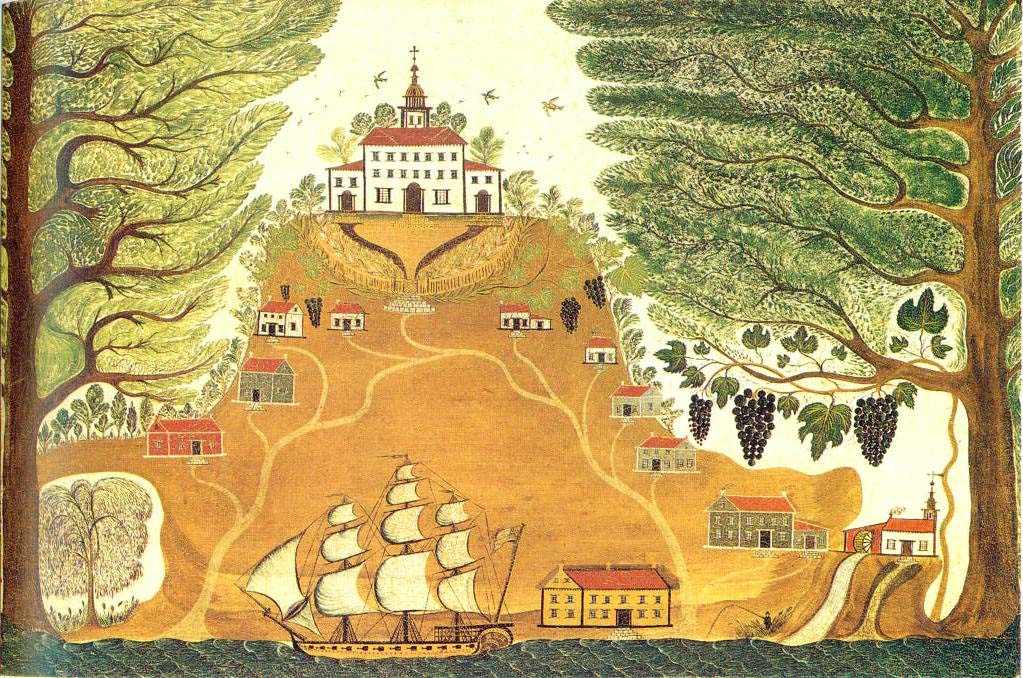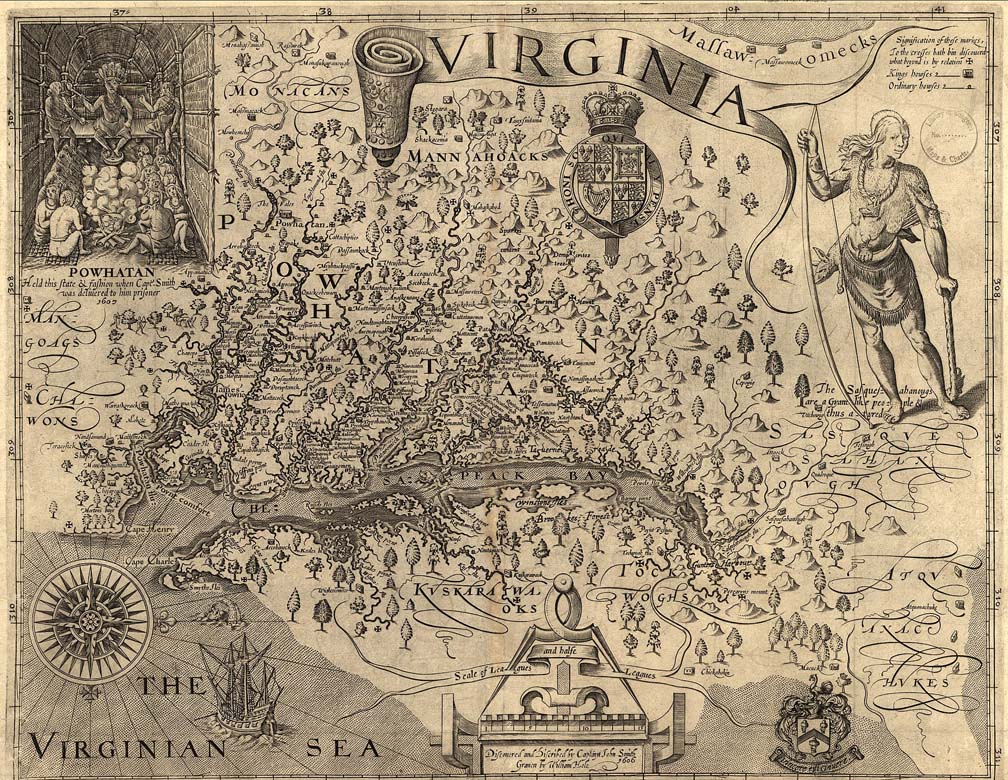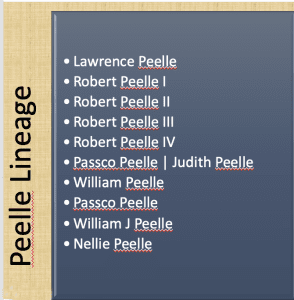
Lawrence Peelle (Peale, Peele), born about 1601 in England, is believed to be our earliest ancestor in America. The line can be traced back to Robert, who is believed to be Lawrence’s son per location and associations.
In 1620, Lawrence boarded the ship the Margaret & John for the trip across the Atlantic. Some people record the date this journey began as December 1620 and others record it as February 1620. The latter is believed to be correct as the year in that era started on March 25 and that would match the end of 1620.
The plan for 1620/1621 of the London Company of Virginia (often referred to simply as the London Company), who arranged the trip, called for 800 people to be sent to the colonies. Over half were to be farmers, carpenters, potters, and men of other skills. The remainder were maids, boys, and servants.
By this time, the London Company had come up with a plan to finance voyages by dangling land in front of potential colonist. They got the people to pay for passage. Then they would get rights to 50 acres of land per person. And, the London Company would continue to profit as they required the colonists pay a fee each year to use the land.
Adversity On The Sea
The Margaret and John set sail in the capable hands of Captain Anthony Chester. The conditions weren’t ideal and passage across the Atlantic was a rough and unforgiving one. The ship was packed with future colonists and provisions bound for Virginia.
There wasn’t a first-class section or even many accommodations for the passengers. Everyone and everything simply shared space on the 150-ton ship. The trip was long, cold, and wet. Between those factors, minimal food, and sea sickness, the trip was often miserable. In addition, stench on the ship would have been horrible.
The Sea Fight
The ship traveled through the Lesser Antilles as a voyage directly west wasn’t possible given the winds and current. When approximately 100 miles northwest of Guadalupe, the Margaret and John encountered two larger ships flying the Dutch flag. Once together, the other two ships tossed aside the Dutch flag, replacing them with the Spanish flag, which meant trouble for the Margaret and John. The Spaniards disliked the English settling in North America and they made that clear to the English every chance they got. And, that day the Margaret and John was in for a fight.
The Spanish ships dwarfed the Margaret and John with the larger being twice the tonnage. Both were also far more equipped for battle than the English ship. Over the course of six hours, a war of words and cannon balls was fought. The battle ended when the English, which could only use 4 of their 8 cannons due to goods on board, disabled one of the Spanish ships and killed many of the men aboard the ships. However, by the time the conflict ended, approximately a third of the people on board the Margaret and John had been killed or injured with 10 killed and approximately 20 injured.

A Strange Land
Lawrence arrived in Virginia from England in May of 1621. The number of settlers in Virginia at the time was quite small. By that spring the London Company records stated that only 603 Europeans were living in Virginia. Nearly, a third of the ones living there the year before had died. It is estimated that only about 25% of the people that left England for Virginia survived the journey and the next few years that followed.
Lawrence was a lucky one. He settled in Elizabeth Cittie. Life was never easy. The land, diseases, the weather, limited supplies, and more presented challenges for the colonists. The Colonist’s version of ordering from Amazon and having something delivered was to send a request back to England with the Captain of a ship. That request then had to be filled and shipped back to Virginia.
Indian Massacre
The Treaty
Several years before Lawrence’s arrival, the local Native Americans (Indians) in the area had agreed to a treaty with the Colonists. The English wanted to be safe from attack and had agreed to defend the Native Americans from other hostile tribes. The two groups became friendly with each other, visited, and moved unarmed amongst each other.
The Attack
In 1622, the King of England reminded the Native American tribe of their prior treaty. Both sides stated that they were in full agreement. However, that was about to change. One day the Native Americans visited with the Colonists and they joined together in a meal, which was not uncommon. Then suddenly, the Native Americans launched a large-scale attack on the settlers, killing men, women, and children. It is also said that they flaunted and celebrated their killing spree.
The reason for the Native American’s attack isn’t known with people debating the motive. It is possible it was revenge for a Native American being killed after the English believed he killed one of their own. Another theory was that they wanted to trade for weapons and the English were reluctant to do so. No matter the reason, it greatly changed the relationship between the Colonists and the Native Americans. The English were more wary of the Indians. As soon as the King of England heard about the incident, he ordered the Native Americans’ crops and homes to be destroyed. He also sent lots of weapons and ammunition so the Colonists could defend themselves.
Captain Tucker, who was in charge of Elizabeth Cittie and the adjoining plantation, received an order to account for the living and the dead following the massacre. Lawrence was listed among the living. However, 347 people were killed. The number might have been an even larger had not an Indian who was close to one of the Colonists alerted him to what was happening.
The Royal Commission
In 1623, an investigation into the London Company’s finances was began. The next year, the company lost its charter to colonize Virginia. The King of England took control of Virginia.
In 1624-25, the Royal Commission under the king’s direction, took a “census” to determine who lived in the Virginia settlement. Lawrence is listed in the census as “Larence Peale.” He was 23 years-old and listed as the head of household having one house. William Smith, age 30, who had arrived on the ship the Jacob in 1624, is living with him. The provisions they had on hand included: 4 barrels of corn, 2 bushels of peas, 300 ct fish, 2 weapons, 6 pounds of powder, and 6 pounds of lead.
From the inventory, Lawrence’s role in the colonies was not clear. However, being a servant can be eliminated as he is listed with having a house. Plus, servants were indicated as a servant to a particular person.

Testimony
On December 30, 1625, Lawrence testified in General Court regarding statements made by Robert Leister regarding Captain Tucker. In those comments, he stated that about 3 years earlier (1622) he heard Mr. Leister say that the Captain “had said harsh words to him which grieved him very much and he said he would be revenged of Captain Tucker if he lived.”
This shows Lawrence’s closeness to Captain Tucker. However, I did not find the details surrounding the need for such a statement.
As The Colonies Grow
As the Colonies grew, Lawrence become more established. He settled in or near Elizabeth Citti. He appears to have married an unknown woman and fathered at least one son by about 1635. His son’s name was Robert, a name that was a family name for many generations.
Afterward: Robert As Lawrence’s Son
The relationship between Lawrence and Robert is based on location and timing. Per Horace Peele, who extensively researched the family, no records have been found of an immigrant named “Robert Peele” until after 1700. However, this Robert Peelle purchased land in the mid-1600s. Additionally, he purchased land adjoining Captain Tucker’s land in Lower Norfolk County, Virginia. This places him close to Captain Tucker and Lawrence clearly was in the same area that the captain lived. It remains possible, however, that Robert came from England and no record of his arrival was made.